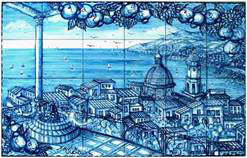Speaker
Mrs
Laura Ghalachyan
(G.S. Davtyan Institute of Hydroponics Problems NAS RA)
Description
Artificial radionuclides (RN, 90Sr-T1/2=28.6 years, 137Cs-T1/2=30.1 years) dangerous for health are released to ecosystems because of human influence in the field of nuclear energetics RN can penetrate into human organism through water-soil-plant chain. Armenian NPP (ANPP, opened in 1976, operated till 1989, reoperated in 1995) is in a densly populated area of the Ararat Valley with intensive agriculture. ANPP uses the water of the River Metsamor. Unbalance waters of the ANPP fall into the Metsamor River which is used for irrigation of the soils. Since 1996 we have carried out radiomonitoring researches in water- soil-plant ecosystems in zones of the ANPP with a radius of 2-15 km. The aim of the studies is to develop practical radioprotective activities for getting ecologically pure food.
The results of investigations have shown that the content of 90Sr fluctuated between 2.2-8.8 Bq/kg and 137Cs between 4.0-13.1 Bq/kg in vegetable crops (basil, celery, dill, parsley, lettuce, pepper, tomato, eggplant, marrow, cucumber, cabbage, potato, cauliflower) which were grown in gray soils and irrigated with the water of the Metsamor River. It is caused by joint influence of many factors, especially biological peculiarities of crops (vegetation duration, mineral nutrition, form of expansion of roots in the soil, watering regime, anatomical structure of leaves, their size etc.). We can conclude that RN penetrated into crops through irrigation water, soil as well as atmosphere. It also turned out that in soil-plant system the observed ratio (OR=90Sr/137Cs in plant¸90Sr/137Cs in soil) <1 for crops, that is, 137Cs accumulated in the crops more than 90Sr. The OR>1 and the absorption of 90Sr exceeded 137Cs for vegetable marrow and cucumber. Accumulation coefficient (AC=content of RN in the plants¸content of RN in soil) AC 90Sr>AC 137Cs 1,3 times for cucumber and AC 137Cs >AC 90Sr 1.2 - 3.0 times for other crops. There is a positive strong comparative connection between OR and AC90Sr for vegetable crops (correlation coefficient is r=0.81±0.14) and there is negative weak comparative connection between OR and AC137Cs (r=-0.30±0.23). RN content in crops hasn’t increased during 2002-2011and doesn’t exceed the MACL. We can conclude that, ANPP doesn’t have any radioecological danger for people who live in the Ararat Valley, as well as residents of neighboring regions.
The researches have been implemented since 2011 in the context of project 11-1f262 of Ministry of Science of RA.
Author
Mrs
Laura Ghalachyan
(G.S. Davtyan Institute of Hydroponics Problems NAS RA)
Co-authors
Mrs
Anahit Aristakesyan
(G.S. Davtyan Institute of Hydroponics Problems NAS RA)
Ms
Ani Asatryan
(G.S. Davtyan Institute of Hydroponics Problems NAS RA)
Mrs
Katush Kocharyan
(G.S. Davtyan Institute of Hydroponics Problems NAS RA)
Mrs
Lusik Tadevosyan
(G.S. Davtyan Institute of Hydroponics Problems NAS RA)

